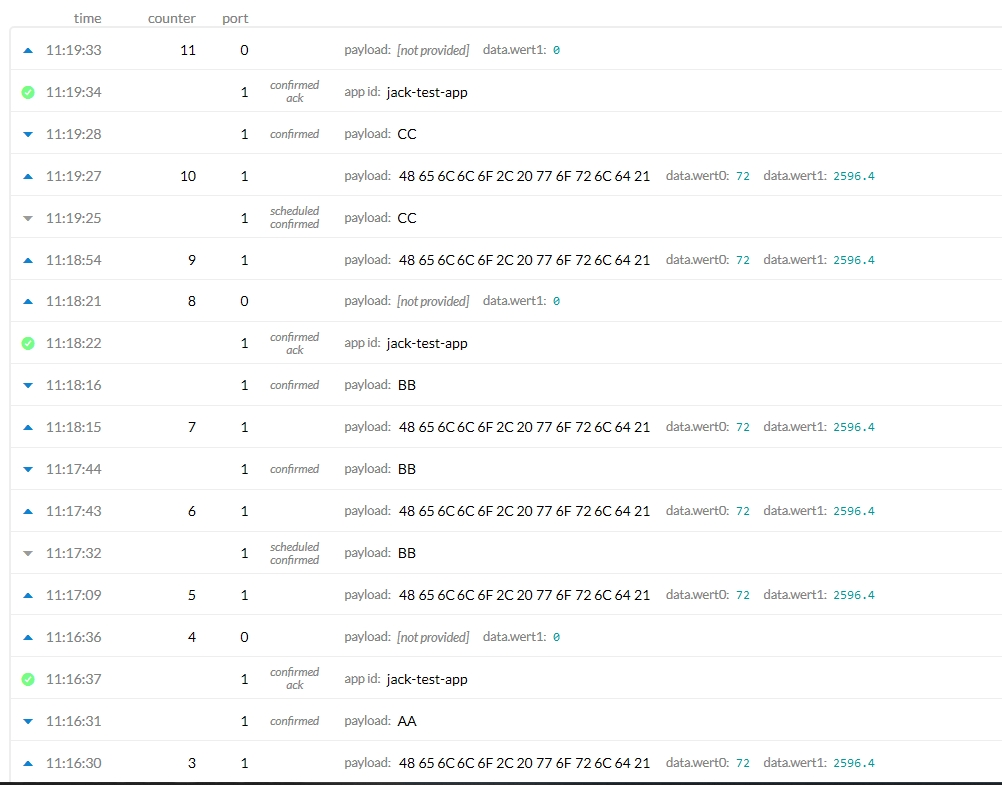@JackGruber It seems like that it was only luck that your code did something. I wondered that my node only used one channel (with your code modified in the post above this one ) and started investigating
First of all I noticed that the array with the bands is missing which stores the duty cycles and the usages of the channel etc.
When I was typing the corresponding memcpy command I noticed that you switched the destination and the source parameter in your code . Also MAX_CHANNELS as the size parameter is wrong because the command wants a size in bytes and not the count of array entries. So we need to multiply MAX_CHANNELS with the size of the array entries:
memcpy(RTC_LORAWAN_channelDrMap, LMIC.channelDrMap, MAX_CHANNELS*sizeof(u2_t));
It would be nice if you change this in your code block so that other readers of this thread don’t copy a switched memcpy 
Currently this code block is working ( I did something with the duty cycle because after deep sleep the ESP resets the system clock):
RTC_DATA_ATTR u4_t RTC_LORAWAN_netid = 0;
RTC_DATA_ATTR devaddr_t RTC_LORAWAN_devaddr = 0;
RTC_DATA_ATTR u1_t RTC_LORAWAN_nwkKey[16];
RTC_DATA_ATTR u1_t RTC_LORAWAN_artKey[16];
RTC_DATA_ATTR u4_t RTC_LORAWAN_seqnoUp = 0;
RTC_DATA_ATTR u4_t RTC_LORAWAN_seqnoDn;
RTC_DATA_ATTR u1_t RTC_LORAWAN_dn2Dr;
RTC_DATA_ATTR u1_t RTC_LORAWAN_dnConf;
RTC_DATA_ATTR s1_t RTC_LORAWAN_adrTxPow;
RTC_DATA_ATTR u1_t RTC_LORAWAN_txChnl;
RTC_DATA_ATTR s1_t RTC_LORAWAN_datarate;
RTC_DATA_ATTR u4_t RTC_LORAWAN_channelFreq[MAX_CHANNELS];
RTC_DATA_ATTR u2_t RTC_LORAWAN_channelDrMap[MAX_CHANNELS];
RTC_DATA_ATTR u4_t RTC_LORAWAN_channelDlFreq[MAX_CHANNELS];
RTC_DATA_ATTR band_t RTC_LORAWAN_bands[MAX_BANDS];
RTC_DATA_ATTR u2_t RTC_LORAWAN_channelMap;
RTC_DATA_ATTR s2_t RTC_LORAWAN_adrAckReq;
RTC_DATA_ATTR u1_t RTC_LORAWAN_rx1DrOffset;
RTC_DATA_ATTR u1_t RTC_LORAWAN_rxDelay;
void Sleep(int sleepSeconds)
{
Serial.println(F("Save LMIC to RTC ..."));
RTC_LORAWAN_netid = LMIC.netid;
RTC_LORAWAN_devaddr = LMIC.devaddr;
memcpy(RTC_LORAWAN_nwkKey, LMIC.nwkKey, 16);
memcpy(RTC_LORAWAN_artKey, LMIC.artKey, 16);
RTC_LORAWAN_dn2Dr = LMIC.dn2Dr;
RTC_LORAWAN_dnConf = LMIC.dnConf;
RTC_LORAWAN_seqnoDn = LMIC.seqnoDn;
RTC_LORAWAN_seqnoUp = LMIC.seqnoUp;
RTC_LORAWAN_adrTxPow = LMIC.adrTxPow;
RTC_LORAWAN_txChnl = LMIC.txChnl;
RTC_LORAWAN_datarate = LMIC.datarate;
RTC_LORAWAN_adrAckReq = LMIC.adrAckReq;
RTC_LORAWAN_rx1DrOffset = LMIC.rx1DrOffset;
RTC_LORAWAN_rxDelay = LMIC.rxDelay;
memcpy(RTC_LORAWAN_channelFreq, LMIC.channelFreq, MAX_CHANNELS*sizeof(u4_t));
memcpy(RTC_LORAWAN_channelDrMap, LMIC.channelDrMap, MAX_CHANNELS*sizeof(u2_t));
memcpy(RTC_LORAWAN_channelDlFreq, LMIC.channelDlFreq, MAX_CHANNELS*sizeof(u4_t));
memcpy(RTC_LORAWAN_bands, LMIC.bands, MAX_BANDS*sizeof(band_t));
RTC_LORAWAN_channelMap = LMIC.channelMap;
//System time is resetted after sleep. So we need to calculate the dutycycle with a resetted system time
delay(random(1000));
unsigned long now = millis();
Serial.println(now);
for(int i = 0; i < MAX_BANDS; i++) {
ostime_t correctedAvail = RTC_LORAWAN_bands[i].avail - ((now/1000.0 + sleepSeconds ) * OSTICKS_PER_SEC);
if(correctedAvail < 0) {
correctedAvail = 0;
}
RTC_LORAWAN_bands[i].avail = correctedAvail;
}
esp_sleep_enable_timer_wakeup(1000000 * sleepSeconds);
esp_deep_sleep_start();
}
void Wakeup()
{
Serial.println(F("Load LMIC from RTC ..."));
LMIC_setSession(RTC_LORAWAN_netid, RTC_LORAWAN_devaddr, RTC_LORAWAN_nwkKey, RTC_LORAWAN_artKey);
LMIC_setSeqnoUp(RTC_LORAWAN_seqnoUp);
LMIC_setDrTxpow(RTC_LORAWAN_datarate, RTC_LORAWAN_adrTxPow);
memcpy(LMIC.bands, RTC_LORAWAN_bands, MAX_BANDS*sizeof(band_t));
memcpy(LMIC.channelFreq, RTC_LORAWAN_channelFreq, MAX_CHANNELS*sizeof(u4_t));
memcpy(LMIC.channelDlFreq, RTC_LORAWAN_channelDlFreq, MAX_CHANNELS*sizeof(u4_t));
memcpy(LMIC.channelDrMap, RTC_LORAWAN_channelDrMap, MAX_CHANNELS*sizeof(u2_t));
LMIC.seqnoDn = RTC_LORAWAN_seqnoDn;
LMIC.dnConf = RTC_LORAWAN_dnConf;
LMIC.adrAckReq = RTC_LORAWAN_adrAckReq;
LMIC.dn2Dr = RTC_LORAWAN_dn2Dr;
LMIC.rx1DrOffset = RTC_LORAWAN_rx1DrOffset;
LMIC.rxDelay = RTC_LORAWAN_rxDelay;
LMIC.txChnl = RTC_LORAWAN_txChnl;
LMIC.channelMap = RTC_LORAWAN_channelMap;
}
Im sure that there are some attributes missing. I will add them in this post when I know about them 
Anyway: Thank you @JackGruber for giving me the right hint to persist the attributes in the RTC  This was really helpful!
This was really helpful!


 …
…